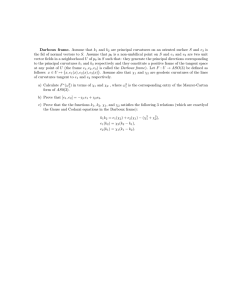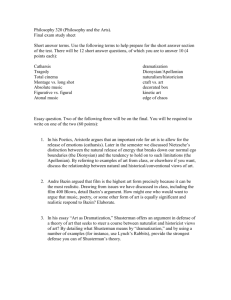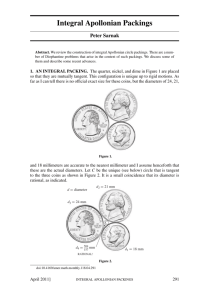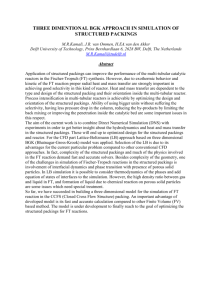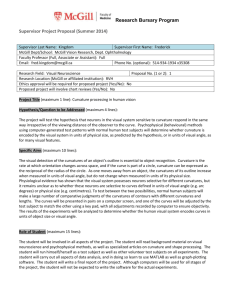PUBLICATIONS DE L’INSTITUT MATHÉMATIQUE Nouvelle série, tome 89(103) (2011), 11–17 DOI: 10.2298/PIM1103011D
advertisement
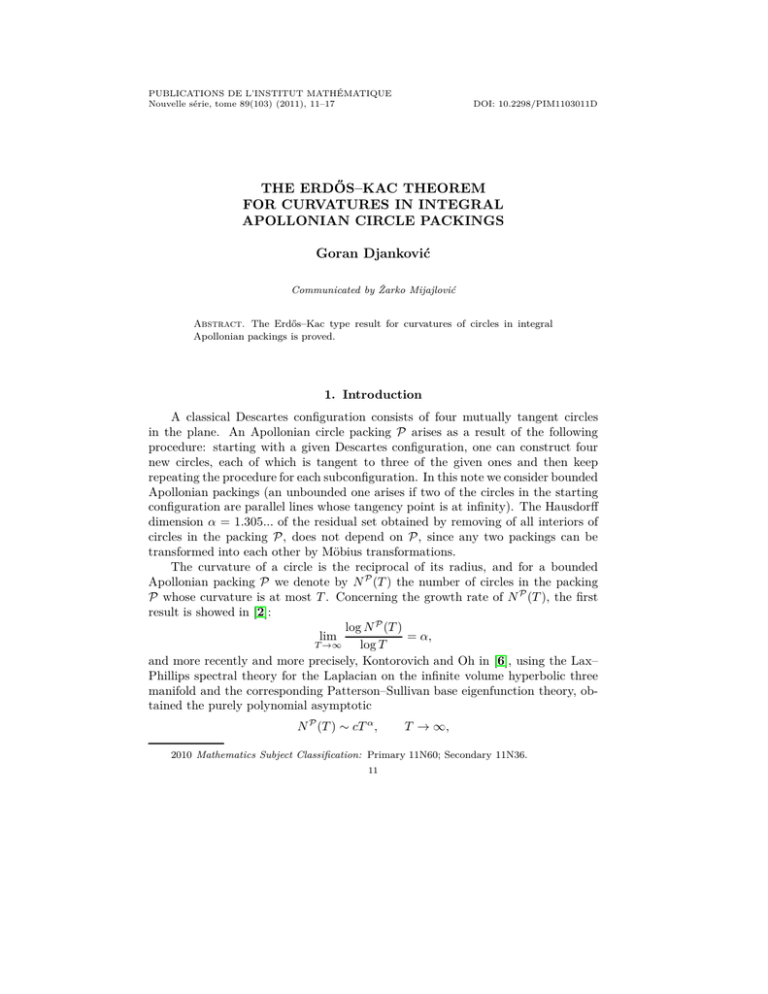
PUBLICATIONS DE L’INSTITUT MATHÉMATIQUE
Nouvelle série, tome 89(103) (2011), 11–17
DOI: 10.2298/PIM1103011D
THE ERDŐS–KAC THEOREM
FOR CURVATURES IN INTEGRAL
APOLLONIAN CIRCLE PACKINGS
Goran Djanković
Communicated by Žarko Mijajlović
Abstract. The Erdős–Kac type result for curvatures of circles in integral
Apollonian packings is proved.
1. Introduction
A classical Descartes configuration consists of four mutually tangent circles
in the plane. An Apollonian circle packing P arises as a result of the following
procedure: starting with a given Descartes configuration, one can construct four
new circles, each of which is tangent to three of the given ones and then keep
repeating the procedure for each subconfiguration. In this note we consider bounded
Apollonian packings (an unbounded one arises if two of the circles in the starting
configuration are parallel lines whose tangency point is at infinity). The Hausdorff
dimension α = 1.305... of the residual set obtained by removing of all interiors of
circles in the packing P, does not depend on P, since any two packings can be
transformed into each other by Möbius transformations.
The curvature of a circle is the reciprocal of its radius, and for a bounded
Apollonian packing P we denote by N P (T ) the number of circles in the packing
P whose curvature is at most T . Concerning the growth rate of N P (T ), the first
result is showed in [2]:
log N P (T )
= α,
lim
T →∞
log T
and more recently and more precisely, Kontorovich and Oh in [6], using the Lax–
Phillips spectral theory for the Laplacian on the infinite volume hyperbolic three
manifold and the corresponding Patterson–Sullivan base eigenfunction theory, obtained the purely polynomial asymptotic
N P (T ) ∼ cT α ,
T → ∞,
2010 Mathematics Subject Classification: Primary 11N60; Secondary 11N36.
11
12
DJANKOVIĆ
for some constant c = c(P) > 0.
The curvatures (a, b, c, d) of four circles in a Descartes configuration satisfy the
quadratic equation
1
a2 + b2 + c2 + d2 = (a + b + c + d)2 ,
2
from which easily follows that if the curvatures in the initial Descartes configuration
of P are integers, then all others are in Z as well, and in that case we say that
the packing P is integral. Moreover, if we assume that gcd(a, b, c, d) = 1 for the
initial curvatures, then we call P a primitive integral. One such configuration is
for example (−6, 11, 14, 23), where −6 indicates different orientation of the outer
circle.
Such integral Apollonian circle packings are the source of intriguing arithmetic
questions, some of them described in [3]. For example, if π P (T ) denotes the number
of circles with prime curvature at most T in bounded, primitive integral Apollonian
packing P, Sarnak showed in [7] that
π P (T ) T
,
(log T )3/2
by reduction to Iwaniec’s result in [5], obtained by half-dimensional sieve. Conjecturally,
Tα
,
π P (T ) ∼ c
log T
α
T
and an upper bound of correct order of magnitude is proved in [6]: π P (T ) log
T.
The classical Erdős–Kac
theorem
establishes
normal
distribution
of
the
selog n √
quence ω(n)−log
, where ω(n) is the number of distinct prime divisors of n
log log n
and n runs over all natural numbers. One can ask a similar question for any other
arithmetically interesting sequence.
In this note we demonstrate the following Erdős–Kac type result concerning
the distribution of numbers of distinct prime divisors of curvatures in integral Apollonian circle packings:
Theorem 1.1. Let P be any bounded, integral, primitive Apollonian circle
packing, and let AP(T ) be the multiset of curvatures of the circles in P of radius
at least T −1 . Then for all α β, we have:
β
2
− log log T
1
a ∈ AP(T ) | α ω(a)
= √1
√
e−t /2 dt.
lim
β
T →∞ |AP(T )|
log log T
2π α
Notation is standard: f = O(g) or f g means that for some constant C > 0,
|f | Cg and f g means that both f g and g f hold.
2. Sieving data: counting on orbits of a Kleinian group in a cone
In order to gain access to the arithmetic properties of the set of curvatures of
an integral Apollonian packing that are required for the main result, one has to be
able to perform the sieving procedure that we describe in this section. Such a sieve,
THE ERDŐS–KAC THEOREM FOR CURVATURES IN APOLLONIAN PACKINGS
13
on orbits of non-commutative groups is initiated and to the considerable extent developed by Bourgain, Gamburd and Sarnak in [1]. The existence of the underlying
group is exactly the reason why extraction of such an arithmetic information is
possible.
The orthogonal group corresponding to the Descartes quadratic form
1
Q(a, b, c, d) = a2 + b2 + c2 + d2 − (a + b + c + d)2
2
is given by
OQ = {g ∈ GL4 | Q(xg t ) = Q(x) for all x ∈ R4 }.
Also, denote by A = S1 , S2 , S3 , S4 the Apollonian group generated by reflections:
⎛
⎛
⎞
⎞
−1 2 2 2
1 0 0 0
⎜ 0 1 0 0⎟
⎜2 −1 2 2⎟
⎟
⎟
S1 = ⎜
S2 = ⎜
⎝ 0 0 1 0⎠ ,
⎝0 0 1 0⎠ ,
0 0 0 1
0 0 0 1
⎛
⎛
⎞
⎞
1 0 0 0
1 0 0 0
⎜0 1 0 0⎟
⎜0 1 0 0 ⎟
⎟
⎟
S3 = ⎜
S4 = ⎜
⎝2 2 −1 2⎠ ,
⎝0 0 1 0 ⎠ .
0 0 0 1
2 2 2 −1
It is a subgroup of infinite index in OQ (Z) = OQ ∩ GL4 (Z).
All Descartes’ quadruples (a, b, c, d) lie on the cone Q(x) = 0 and moreover, all
unordered Descartes quadruples in a fixed integral packing P can be obtained by
action of A. It is proved in [3, theorems 3.2 and 3.3] that every bounded integral
Apollonian circle packing P contains the unique root quadruple ξ = (a, b, c, d) such
that a < 0 b c d and a + b + c d. This root quadruple ξ enables description
of the set of curvatures occurring in P and counted with multiplicity, in terms of
the orbit ξ.At ⊂ Z4 : it consists precisely of the four entries of ξ and the largest
entry in each ξγ t , where γ ∈ A {I}.
The description of curvatures in P in terms of the orbit ξ.At translates the
problem of counting such circles with curvatures at most T to counting points on
the orbit inside the cone:
B(T ) = {x = (x1 , x2 , x3 , x4 ) ∈ R4 | Q(x) = 0, x T },
while the curvature itself can be recovered as the value x1 (ξγ) of the polynomial
x1 at the orbit point.
Because of this setup and symmetry between a, b, c, d, we will investigate Erdős–
Kac statistic on the multiset (counting with multiplicities)
AP(T ) = {a | (a, b, c, d) a Descartes config. in P with max(|a|, |b|, |c|, |d|) T }
of curvatures at most T in the packing P.
Now if we denote by ι : SL2 (C) ∼
= SpinQ (R) → SOQ (R) the spin double
−1
◦
cover, let Γ = ι (SOQ (R) ∩ A). Since ι factors through SL2 (C) → PSL2 (C), the
group Γ is recognized as a Kleinian group, that is a discrete subgroup of Isom(H3 ),
where H3 = {(x1 , x2 , y) ∈ R3 | y > 0} is the hyperbolic upper half-space with the
14
DJANKOVIĆ
dx2 +dx2 +dy 2
metric 1 y32
. The limit set Λ(Γ) of a Kleinian group Γ is defined as a set
of limit points of an orbit Γz, z ∈ H3 in the boundary ∂∞ (H3 ) = C ∪ {∞}. The
Hausdorff dimension of Λ(Γ) is denoted with δΓ , and in the case of Γ coming from
the Apollonian group A, δΓ = α. For more information about these identifications,
cf. [6].
The base eigenvalue in Spec(Γ H3 ), the spectrum of the Laplace operator Δ
on L2 (Γ H3 ), is given by λ0 = δΓ (2 − δΓ ) = α(2 − α). The principal congruence
subgroups of Γ are defined by
Γ(d) = {γ ∈ Γ | γ ≡ I
(mod d)},
and for them Spec(Γ(d) H3 ) ⊇ Spec(Γ H3 ). We will encounter for any squarefree d also the following congruence subgroups Γξ (d) = {γ ∈ Γ | ξγ ≡ ξ (mod d)} ⊇
Γ(d); obviously StabΓ (ξ) = StabΓξ (d) (ξ).
The cornerstone of the required counting results is the following spectral gap
theorem (because of which it was necessary to pass from A to Γ):
Theorem (Bourgain, Gamburd, Sarnak). For any Zariski dense subgroup Γ
of SpinQ (Z), with δΓ > 1, there exists θ ∈ [1, δΓ ), such that for all square-free
integers d,
Spec(Γ(d) H3 ) ∩ [θ(2 − θ), δΓ (2 − δΓ )] = {δΓ (2 − δΓ )}.
From the initial multiset AP(T ), we define the sifting sequence A(T ) = {an (T )},
where
an (T )prelim. =
1.
γ∈At
ξγT
x1 (ξγ)=n
In fact, because of the counting results in [6], we will switch to Γ and moreover we
will count with a smoothed weight wT (from definition 8.3 in [6], which controls
the norm condition ξγ T by its support):
wT (γ).
an (T ) =
γ∈StabΓ (ξ)Γ
x1 (ξγ)=n
The crucial ingredient that we need is the asymptotic formula for square-free d,
uniformly in some range d D, for the quantity
an (T ) =
wT (γ)
|Ad (T )| =
n≡0 (d)
=
γ∈StabΓ (ξ)Γ
x1 (ξγ)≡0 (d)
wT (γγ1 ).
γ1 ∈Γξ (d)Γ γ∈StabΓ (ξ)Γξ (d)
x1 (ξγ1 )≡0 (d)
Now the inner sum can be evaluated using the spectral gap theorem given above
[6, Proposition 8.7]: there exists ε0 > 0, uniform over all square-free integers d,
THE ERDŐS–KAC THEOREM FOR CURVATURES IN APOLLONIAN PACKINGS
15
such that for any congruence subgroup Γξ (d) < Γ and for any γ1 ∈ Γ,
cξα
T α + O(T α−ε0 ),
wT (γγ1 ) =
α[Γ:Γξ (d)]
γ∈StabΓ (ξ)Γξ (d)
where c > 0 is a constant depending on Γ and the smoothing parameters involved
in w, but of course, independent of d. Together we have
1
1−ε0
X + O(X
) ,
(2.1)
|Ad (T )| = Ox1 (d)
[Γ:Γξ (d)]
where
Ox1 (d) =
1 and X = α−1 cξα T α is a total mass.
γ1 ∈Γξ (d)Γ
x1 (ξγ1 )≡0 (d)
O
(d)
x1
Moreover, if we set g(d) := [Γ:Γ
, then g is multiplicative in the following sense:
ξ (d)]
there is a finite set of bad primes B such that g(d1 d2 ) = g(d1 )g(d2 ) for any squarefree d1 d2 with no prime factors in B. Moreover, for any prime p not in B, 0 <
g(p) < 1 and
1 1
(2.2)
g(p) = + O 3/2 .
p
p
For the proof of this, we refer to [1] or [6].
3. The Erdős–Kac for small prime divisors
We assume that for a finite multiset à of X natural numbers (or associated
sifting sequence A = (an = |{a ∈ Ã : a = n}|)n ) we can find a real valued, nonnegative multiplicative function g(d), by means of which we can model the sequence
A in the following sense: for a square-free d,
1=
an = g(d)X + rd ,
|Ad | =
a∈Ã
d|a
n≡0 (d)
where g(d) ∈ [0, 1] represents “probability" of finding elements in A with d|n and
rd has a role of remainder term and should be small for each d or at least small
on average in some range of d. In this general sieving environment Granville and
Soundararajan proved the following moment result which describes the distribution
of the number of “small" prime divisors of elements in Ã. For a fixed parameter
z > 0, let ωz (n) denote the number of different primes p z which divide n.
Proposition (Granville, Soundararajan [4]). Let
μz =
g(p) and σz2 =
g(p)(1 − g(p));
pz
pz
2/3
σz
then uniformly for all natural numbers k we have
3 k
k
k
(3.1)
(ωz (a) − μz ) = Ck Xσz 1 + O
+ O μkz
σz2
a∈Ã
d∈Dk (z)
|rd | ,
16
DJANKOVIĆ
for k even, and
(3.2)
(ωz (a) − μz )k Ck Xσzk
a∈Ã
k 3/2
+ μkz
σz
|rd |,
d∈Dk (z)
for k odd. Here Dk (z) denotes the set of square-free integers which are the product
.
of at most k primes z and Ck = 2k/2Γ(k+1)
Γ(k/2+1)
4. Proof of Theorem 1.1
It will be enough to calculate asymptotically the moments
(ω(a) − log log T )k ,
(4.1)
a∈AP(T )
for any fixed k. In fact asymptotic will hold uniformly for k (log log T )1/3 .
Information about the distribution of small prime divisors provided by Proposition
from Section 3 applied on multiset AP(T ) is sufficient to extract the correct leading
term. Therefore, using (2.2) we find
μz = σz2 = log log z + O(1).
Moreover, since |Ox1 (p)| = p2 +O(p3/2 ) for all p not in B, we have |Ad | = g(d)X +rd
for all square-free d without prime factors in B, X T α defined as in Section 2
and from (2.1):
|rd | d2 X 1−ε0 .
Set z = T 1/s , for some parameter s > 0, to be chosen later. Hence, we
approximate
ω(a)− log log T = ωz (a)− μz + (ω(a)− ωz (a))+ (μz − log log T ) = ωz (a)− μz + O(s),
and consequently, for some positive absolute constant c, the moment (4.1) is
k−1
k k
k−l
l
(4.2)
=
(ωz (a) − μz ) + O
|ωz (a) − μz | .
(cs)
l
a∈AP(T )
Since
μlz
a∈AP(T )
l=0
|rd | (log log z)l
d∈Dl (z)
z
log z
l
z 2l X 1−ε0 ,
as soon as z X ε0 /3k = T αε0 /3k , the rightmost error terms in (3.1) and (3.2)
are negligible. Now for the main term one can use directly the proposition, while
in the error term for 0 l k − 1 and l even we use (3.1), and for l odd, by
Cauchy–Schwarz
1/2
1/2
l
l−1
l+1
|ωz (a) − μz | (ωz (a) − μz )
(ωz (a) − μz )
a∈AP(T )
a∈AP(T )
a∈AP(T )
(Cl−1 Cl+1 )1/2 Xσzl .
THE ERDŐS–KAC THEOREM FOR CURVATURES IN APOLLONIAN PACKINGS
17
2/3
3k
Taking s = αε
and since we assume that k σz (range of uniformity required
0
for the proposition) the error term in (4.2) is bounded by
k−1
k max(Cl , Cl−1 Cl+1 ) 3c k k−l
k− 1
k
Ck Xσz 3 .
Ck Xσz
Ck
αε0 σz
l
l=0
Hence, for all k ∈ Z>0 we have as T → ∞
k!
ω(a) − log log T k
, k even;
1
2k/2 (k/2)!
√
→
|AP(T )|
0,
k odd.
log log T
a∈AP(T )
Since on the right hand side are the moments of a random variable with the normal
distribution N (0, 1), and the moments uniquely determine the distribution, the
proof is finished.
References
1. J. Bourgain, A. Gamburd, P. Sarnak, Affine linear sieve, expanders, and sum-product, Invent.
Math. 179 (2010), 559–644
2. D. Boyd, The sequence of radii of the Apollonian packing, Math. Comp. 39(159) (1982), 249–
254
3. R. Graham, J. Lagarias, C. Mallows, A. Wilks, C. Yan, Apollonian circle packings: number
theory, J. Number Theory 100 (2003), 1–45
4. A. Granville, K. Soundararajan, Sieving and the Erdős–Kac theorem: in: Andrew Granville,
and Zeév Rudnick (eds), Proc. NATO Adv. Study Inst. on Equidistribution in Number Theory,
Montreal, NATO Sci. Ser. II, Math. Phys. Chem. 237, Springer, pp. 15Ű-27.
5. H. Iwaniec, Primes represented by quadratic polynomials in two variables, Acta Arith. 24
(1974), 435–459
6. A. Kontorovich, H. Oh Apollonian circle packings and closed horospheres on hyperbolic 3manifolds (with Appendix by H. Oh, N. Shah), arXiv: 0811.2236v4
7. P. Sarnak, Letter to J. Lagarias about Integral Apollonian Packings, 2007; available at
www.math.princeton.edu/sarnak
University of Belgrade
Faculty of Mathematics
11000 Belgrade
Serbia
djankovic@matf.bg.ac.rs
(Received 09 07 2010)

